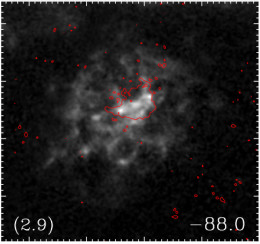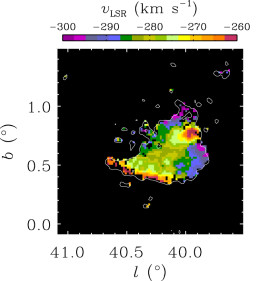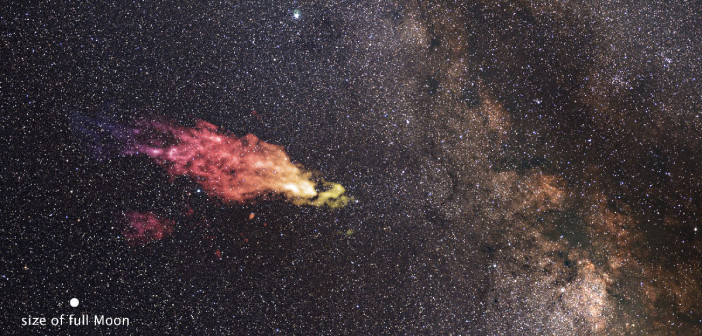What caused the newly discovered “supershell” in the outskirts of our galaxy? A new study finds evidence that a high-velocity cloud may have smashed into the Milky Way’s disk millions of years ago.
Mysterious Gas Shells

A single velocity-channel map of the supershell GS040.2+00.6–70, with red contours marking the high-velocity cloud at its center. [Adapted from Park et al. 2016]
How do these structures form? One theory is that they result from several supernovae explosions occurring in the same area. But the energy needed to create a supershell is more than 3 x 1052 erg, which corresponds to over 30 supernovae — quite a lot to have exploding in the same region.
There’s an interesting alternative scenario: the supershells might instead be caused by the impacts of high-velocity clouds that fall into the galactic disk.

Velocity data for the compact high-velocity cloud CHVC040. The cloud is moving fast enough to create the supershell observed. [Adapted from Park et al. 2016]
The Milky Way’s Speeding Clouds
High-velocity clouds are clouds of mostly hydrogen that speed through the Milky Way with radial velocities that are very different from the material in the galactic disk. The origins of these clouds are unknown, but it’s proposed that they come from outside the galaxy — they might be fragments of a nearby, disrupting galaxy, or they might have originated from flows of accreting gas in the space in between galaxies.
Though high-velocity clouds have long been on the list of things that might cause supershells, we’ve yet to find conclusive evidence of this. But that might have just changed, with a recent discovery by a team of scientists led by Geumsook Park (Seoul National University).
Using the Arecibo radio telescope in Puerto Rico, Park and collaborators have observed a supershell in the outskirts of the Milky Way — and it has a high-velocity cloud at its center! Could this pair of objects be the evidence needed?
A Revealing Pair
The supershell, GS040.2+00.6–70, is roughly 3,000 light-years across, and it’s in the process of expanding outwards. The interior of the shell is filled with a complex structure that looks almost like spokes extending from a central hub. CHVC040, a compact high-velocity cloud, is located right at the central hub; the authors calculate a probability of less than a thousandth of a percent that this alignment is random.

An integrated intensity map (click for a better look!) of neutral hydrogen showing the overall picture of the supershell (left), with the hub-and-spoke complex structure indicated within the shell. Contours in a close-up view (right) shows the location of the high-velocity cloud directly at the central hub. [Park et al. 2016]
If this scenario is correct, Park and collaborators’ observations demonstrate that some compact high-velocity clouds can survive their trip through the galactic halo to smash into the galactic disk, forming a supershell on impact. A systematic study of the ~300 known compact high-velocity clouds in the Milky Way may reveal other, similar systems of compact high-velocity clouds coincident with supershells.
Citation
Geumsook Park et al 2016 ApJ 827 L27. doi:10.3847/2041-8205/827/2/L27
